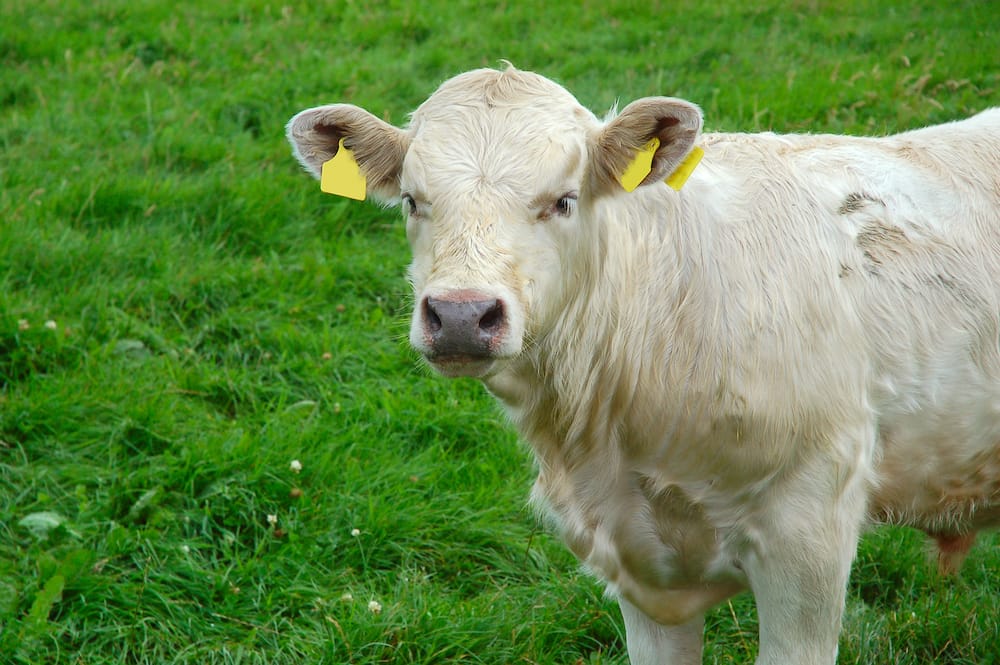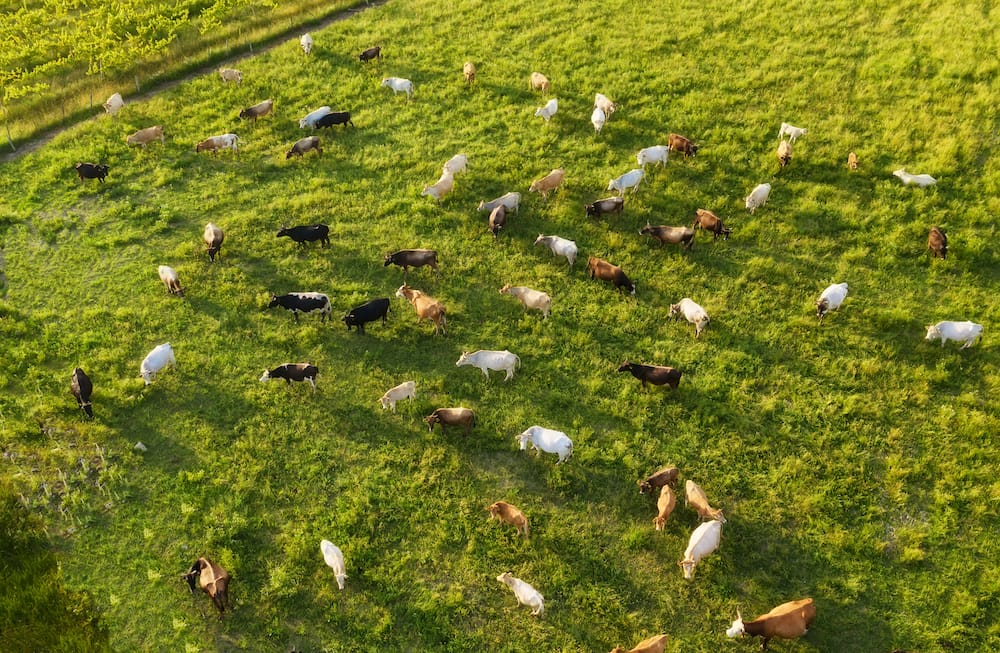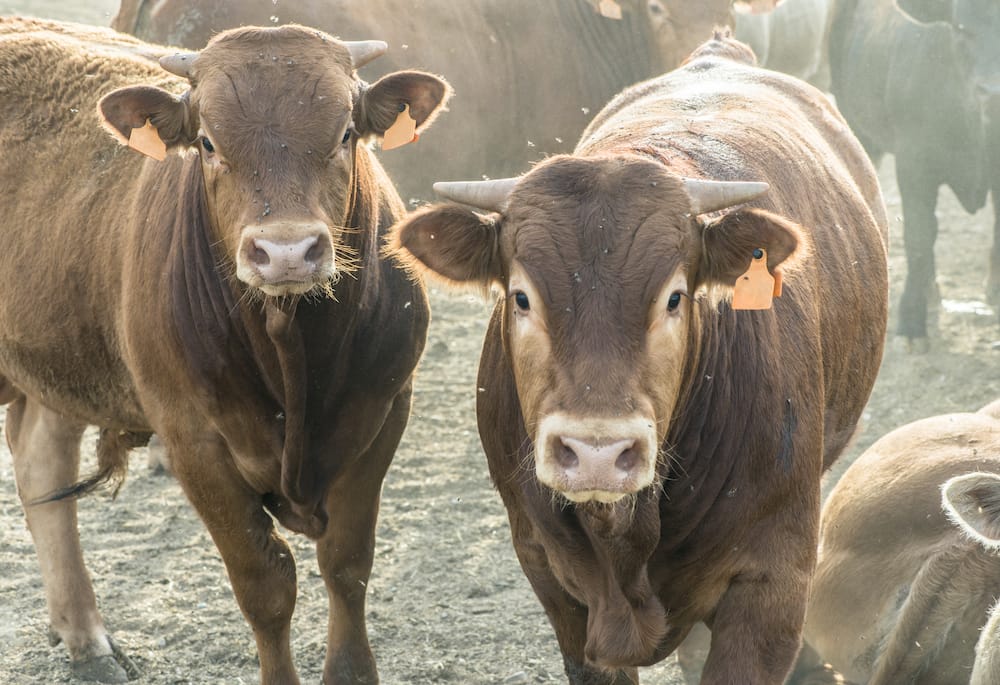Most beef farming operations tend to make money when auction prices are high. And even then, many farmers use off-farm income to help support their business.
In this article, we’ll talk about all the major expenses associated with beef farming. And what you can do to keep them at a minimum and up your profits.
First, let’s understand our basic input costs and what steps we can take to understand and reduce them:
- Determine the money (budget) you have to spend
- Calculate your total cow-calf costs
- Divide your cow costs into categories – pasture, feed, hay production, vet care, labour etc.
- Rank the categories in order of most to least important
High costs of winter feed:
While grass doesn’t cost much, making hay, silage and grain are expensive.
For every pasture rotation, you need your wire, mineral supplements, an ATV. Add to this the cost of your tractors, balers, rakes, the fuel, maintenance costs and labour – and making hay, silage and grain add up to a lot.

It all comes back to extending the grazing season well into winter so that cattle can stay out on pasture for a longer period of time, thereby cutting down production costs. A pasture program doesn’t necessarily need to end right at the onset of winter.
Having said that, it’s important to remember that a cow-calf herd can participate in a winter grazing program only if the calves are born during the growing season.
Let’s explore this a little more:
Calving at the right time:
Cow-calf operations usually calve as early as they can, so that they can sell their weanlings in late fall, once the cattle come off the pasture.
But, calving before the start of the growing season means that cattle cannot coast through the winter season. Cows will need a good feed throughout winter so that they’re healthy enough to calve, or their conception rates suffer.
However, keeping cows on an optimal feed during winter is very expensive.
So what can you do?
Calve during the growing season! Calving can happen about 4-6 weeks after the pastures green up in Spring.
Calving during this time means warmer temperatures, clean pastures and dry ground. This reduces the number of diseases and cows also don’t need that much assistance while calving! Conception rates generally increase with ‘summer calving’.
Now, there are also a few cons to consider before switching to a summer calving program. For instance, in summer calving, your calves will be too young to wean and sell in fall.
So you’ll have to let them stay with their mothers for the major part of the winter. This extra milk that the calves get will help them coast through the winter far more cheaply than if those same calves were to be kept in a feedlot!

Then, the calves can be fattened and sold the next summer.
When you sell heavier calves, your farm will actually produce the same amount of beef, with lesser cows. And lesser cows equal a reduction in the cost of your winter feed!
Effective grazing practices:
What if I told you that effective grazing practice can help you increase dry matter yields, quality of grass, and the weight of your cattle while reducing overall costs and labour?
Well, there is such a strategy. And it’s called rotational grazing based on herbage levels.
A daily pasture rotation recreates a wild herd migration by using small grazing paddocks at any given time and regular pasture moves.
In a daily pasture rotation, the cows learn that they don’t have time to roam around the pasture looking for the best grass. These cows quickly realize that they can’t be picky Polly’s! They have to hurry up and eat whatever they can get their mouths on before another cow grabs it.
This good-natured competition makes the cows graze quickly, on whatever is in their way.
So, the pasture (including the weeds) gets grazed evenly and the stubble that’s left behind is uniform, almost like a lawnmower went through it!
The cows also benefit from this. They eat faster, and they eat more, resulting in faster cattle weight gain.
Think of it like kids at a birthday party. All the little munchkins rush to the cake first, because they want to get their hands on a nice meaty slice before it vanishes! And then they continue to eat all the other party snacks, because, hey, that’s what the other kids are doing too.
You can use a smart electric fence grid to create a daily pasture rotation that either speed up or slow down, depending on the grass growth, since you’re not obliged to a fixed pasture size.
Picking your cattle:
As you already know, it’s important to pick cattle breeds that are well suited to the climatic conditions on your farm.
From cold and heat tolerance to eye pigments for bright climates, firm feet for rocky terrain – there are a whole bunch of points to assess before you pick the right cattle for your farm.
The right cattle will improve performance, keep diseases and health complications at bay and lower your overall cost.

As we discussed earlier, for grass-fed beef producers, feeding during winter is expensive. Every winter your cattle spends on your farm before you send them to the butcher will cost you. Slaughter whatever smaller cattle breeds you can so that you can skip the second winter feed and save costs.
In warm climates, the larger cattle breeds work better. Heavier finishing weights mean that the calves will need to spend more time on your farm but you can cut down on your number of cows and still produce the same amount of beef (because of heavy weight cows) and cut down on your production costs.
Culling choices:
As farmers, you’re used to taking tough decisions.
Any cow that needs assistance to calve has to be culled. Calves with health issues should not be given an entry into the breeding herd. Same goes for cattle that cannot conceive, and cattle that loses weight faster than its buddies.
You can always use tools and technology or a service like pasture.io to help you identify the most fertile, low-maintenance cows, heifers and bulls that will up the standard of your herd, and future cattle to come.
Forage analysis:
You have a powerhouse of data at your fingertips.
All you need is a service to give you that valuable information.
Your monthly forage analysis and livestock nutritionists are two major key aspects that will help you cut down your expenses.
There could be a deficiency of a vitamin/mineral in your cow’s diet that could cause health issues. A forage analysis will help point out what’s missing so that you can give your cows the missing supplements and boost their health, fertility and weight gain.
Doing a regular forage analysis can also give you information on just how long you can extend the winter grazing season. You know that your pastures in winter don’t just suddenly change overnight. It’s a slow and steady process.
With a forage analysis, you’ll know exactly how your grass deteriorates and you can supplement your cattle feed with the right nutrients to extend your winter grazing season. For more on this, please head to pasture.io and we’ll help you get all the data you need!
Split your cows into groups:
Separate your cows based on their nutrient needs. This helps in targeted feeding strategies that minimize dominant subordinate relationships and overall feed costs.

For instance, young female cows need more energy and protein, but cannot take as much dry matter as mature cows. So, when you mix cows of different types, young cows don’t get enough to meet their needs and the older cows often end up overeating. So, you could end up with thin young cows and overweight grandfather cows!
This also ends up driving the cost of the feed for the entire herd, to meet the requirement of the younger cows.
The beef industry, just like any industry, is constantly growing and evolving. Every now and then, science gives us some wonderful eye-opening data and tips to help us constantly stay ahead of the game. We hope these cost-saving cattle farming strategies will help you do everything you can to cut your costs and boost your profits!
This brings us to the end of this article. I do hope you enjoyed reading it. Please feel free to leave a comment below and I promise to reply.
Until then, Happy Farming!
- The Dedicated Team of Pasture.io, 2020-09-15